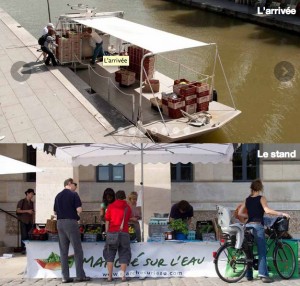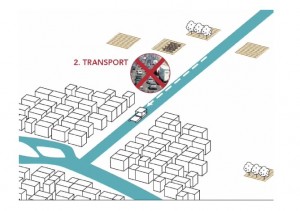Marché sur l’eau
April 24, 2013
Contributors: François Jegou (LE) and Serena Nardin
Workshop: Resource efficiency – CO2 reduction / Food hub/logistic platform
Reinvent Mainstream Logistic


The population growth and further urbanization will have a significant effect on the need for the delivery of goods, especially in urban areas, causing environmental impact, traffic congestion and problems in reaching consumers (last mile logistic).
Some interesting solutions currently in experimentation have been developed using the rivers and canals, which might replace the use of several trucks with a lower carbon intensive mix of transport means.
Marché sur l’eau selected farms in the periurban area outside Paris and close to the canals in order to carry by boat fruits and vegetables and deliver them to the market in the center of the city, reaching directly the consumers. Furthermore, the boat collects organic waste and brings it to a biogas digester in the countryside, close to the river
Environmental benefits:
- Decreasing the usage of transport means from the countryside to the city
- Fostering the recycle of organic waste
- Driving people to consume fresh and local food
Economical benefits:
- Supporting the periurban’s growers and producers
- Respecting both prices of the farmer’s work and the consumer purchasing power
Social benefits:
- Creating long last relationships between local farmers and costumers
- Rivers and canals must be suitable for navigation, so they might need maintenance,
- Little flexibility of sales points (limited to a few selling locations near the canal)
- Little flexibility of products’ offers
- Struggle with controlling the demand and offer (uncertainty of production, season, expiration of food, etc.)
This system of overcoming the sustainability obstacles is applicable only when waterways are available within the city. This model cannot be replicated in every city but it exemplifies potentialities to reinvent the current mainstream logistic systems reusing part of still existing past infrastructures.
How could we offer a rich variety of fresh and local products all year long and with a low environmental impact in terms of food transportation?
What other kinds of existing infrastructures could be used or adapted as new transportation ways?